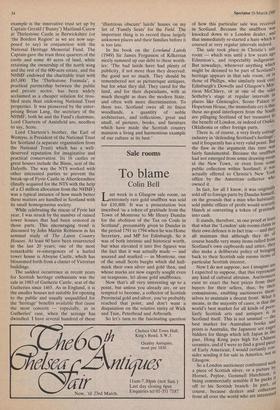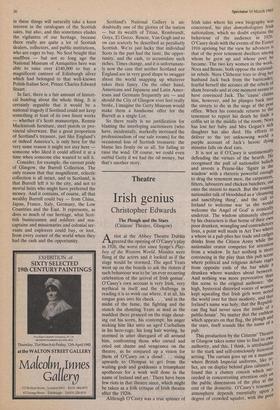Sale rooms
To blame
Colin Bell
Last week in a Glasgow sale room, an extremely rare gold snuffbox was sold for £10,800. It was a presentation box inscribed 'as a token of gratitude from the Town of Montrose to Mr Henry Dundas for the abolition of the Tax on Coals in Scotland', presumably given to Dundas in the period 1791 to 1794 when he was Home Secretary, and MP for Edinburgh. So it was of both intrinsic and historical worth, but what elevated it into five figures was the fact that it was actually made — and assayed and marked — in Montrose, one of the small Scots burghs which did hall- mark their own silver and gold then, and whose marks are now eagerly sought even on teaspoons, let alone gold snuffboxes.
Now that's all very interesting up to a point, but unless you already are, or are tempted to become, a collector of Scottish Provincial gold and silver, you've probably reached that point, and don't want a disquisition on the relative rarity of Wick and Tain, Peterhead and Arbroath.
So let's turn to the fascinating question of how this particular sale was received in Scotland. Because the snuffbox was knocked down to a London dealer, and that immediately re-started a hare which is coursed at very regular intervals indeed. The sale took place in Christie's sale room — which was until a few years ago Edmiston's, and respectably indigenous. But nowadays, whenever anything which might be deemed to be part of Scotland's heritage appears in that sale room, or in those of Phillips, who similarly took over Edinburgh's Dowells and Glasgow's Mor- rison McChlery, or at one of the sales Sotheby's stage at regular intervals in places like Gleneagles, Scone Palace of Hopetoun House, the immediate cry is that these no-good interlopers from the South are pillaging Scotland of her treasures to the benefit of London, or indeed of Osaka, Oklahoma or other foreign parts. There is, of course, a very lively cottage industry in 'defending Scotland's heritage and it frequently has a very valid point. Bat the flaw in the argument this time was fairly fundamental. Because the snuffbox had not emerged from some drawing-roonl iii the New Town, or even from some public collection within Scotland; it Was actually offered to Christie's New Yc'rk office by the American collector wit° owned it. In fact, for all I know, it was originall% sold off to foreign parts by Dundas himselt, on the grounds that a man who habituallY sold public offices of profit would scarcelY blanch at converting a token of gratitude into cash. It stands, therefore, as one proof at least that what the 'London' sale rooms claim in their own defence is in fact true — and theY all maintain that although they do of course handle very many items culled froul Scotland's own cupboards and attics, they also make a deliberate policy of bringing, back to their Scottish sale rooms items 0' particular Scottish interest. Now I do not suppose, nor I imagine ant I expected to suppose, that this represents any kind of cultural altruism. Auctioneers exist to exact the best prices from thOr buyers for their sellers, thus, by their commissions, enabling auctioneers then!' selves to maintain a decent front. What' means, in the majority of cases, is that tbe world's best market for all kinds of pecu- liarly Scottish arts and antiques is in Scotland itself. This is not unusual — the, best market for Australian books all prints is Australia, the Japanese are eager bidders for things which left Japan in the past, Hong Kong pays high for Chinese ceramics, and if I were to find a good piece of Early American, I would certainly con- sider sending it for sale in America, not in Glasgow. So a London auctioneer confronted with a piece of Scottish silver, or a picture bY Horne!, Peploe, Gemmel! Hutchison, t,s. being commercially sensible if he packs If' off to his Scottish branch. In part, ° course, because dealers and collector! from all over the world who are interested
in these things will naturally take a keen interest in the catalogues of the Scottish sales, but also, and this sometimes eludes the vigilantes of our heritage, because there really are quite a lot of Scottish dealers, collectors, and public institutions, who are eager to buy. No Scot bought that snuffbox — but not so long ago the National Museum of Antiquities here was able to raise over £140,000 to buy a magnificent canteen of Edinburgh silver which had belonged to that well-known Polish-Italian Scot, Prince Charles Edward Stuart.
In fact, there is a fair amount of histori- cal humbug about the whole thing. It is certainly arguable that it would be a national tragedy if Scotland could not keep something at least of its own finest works — whether it's Scott manuscripts, Rennie Mackintosh furniture, steel pistols or pro- vincial silverware. But a great proportion of Scotland's treasure, just like England's or indeed America's, is only here for the very same reason it might not stay here — someone who liked it could afford it at a time when someone else wanted to sell it.
Consider, for example, the current pride of Glasgow, the Burrell Collection. The only reason that that magnificent, eclectic collection is all intact, and in Scotland, is that Burrell left it to the city, and not to mortal heirs who might have preferred the money. And it contains, of course, all that wealthy Burrell could buy — from China, Japan, France, Italy, Germany, the Low Countries and the East. It represents, as does so much of our heritage, what Scot- tish businessmen and soldiers and sea- captains and missionaries and colonial ser- vants and explorers could buy, or loot, from every corner of the world when they had the cash and the opportunity. Scotland's National Gallery is un- doubtedly one of the glories of the nation — but its wealth of Titian, Rembrandt, Goya, El Greco, Renoir, Van Gogh and so on can scarcely be described as peculiarly Scottish. We're just lucky that individual Scots in the past had the taste, the oppor- tunity, and the cash, to accumulate such riches. Times change, and it is unfortunate- ly now the case that neither Scotland nor England are in very good shape to swagger about the world snapping up whatever takes their fancy. On the other hand, Americans and Japanese and Latin Amer- icans and Germans frequently are — and should the City of Glasgow ever feel really broke, I imagine the Getty Museum would make them a handsome offer for the Burrell as a single Lot.
So there really is no justification for blaming the interloping auctioneers (who have, incidentally, markedly increased the professionalism of our sale rooms) for the occasional loss of Scottish treasures: the blame lies firmly on us all, for failing to raise the wind. Of course, we could even outbid Getty if we had the oil money, but that's another story.



















































 Previous page
Previous page